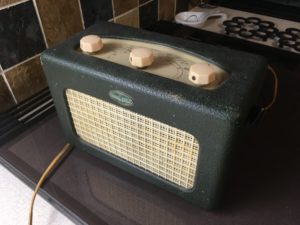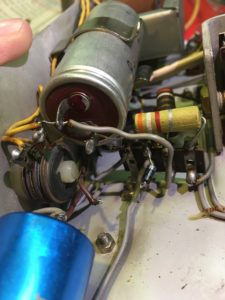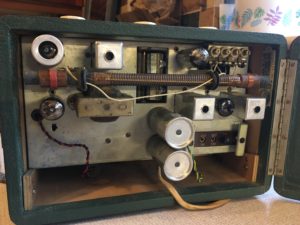Roberts radios have been around for many years, since 1932 in fact, when radio was still quite new. Harry Roberts founded the company, alongside Leslie Bidmead. My heart goes out to Leslie as he had to sell his beloved motorbike to pay for the small factory they started off in. There is more history relating to Roberts Radio on their website but our story concerns the R66.
The Roberts R66 was released in 1956, the design being inspired by a handbag Harry’s wife had owned. It’s a remarkable little radio for the time, covering Medium Wave and Long Wave with a rotating slow motion dial. It came in various colours including red, green, blue and a nice honey colour. The radio had a small turntable fitted on the bottom, so you could rotate the radio easily for best signal strength. Power could be had from a built in mains power supply, or from two quite large batteries, one for the valve heaters and the other for the high tension or HT; neither battery is available new any more so this little radio needs its mains power supply.
I gave this radio to an old friend many years ago, after he took a shine to it; he was a great admirer of what could be done with the small seven pin battery valves. When he passed away last year, the radio came back…and I decided I would get it up and running again.
If you get a chance to buy one, they don’t bring high prices unless in exceptional condition. In 1956 you would have paid £13.19s.9d. plus purchase tax. In 2020s money, that is not far off £500! The quality Roberts radios have always been luxury items.
I gave mine a good clean and took the chassis out, which is quite straight forward. It’s best to desolder the speaker connections so you can use a test speaker and have better access to the chassis. I chose to assume the valves were good, but could easily test and replace them if that turned out to be wrong. Someone had been working on the power supply, having replaced the single, half wave metal rectifier with a 1N4007 in series with a 1.8K resistor; no, that won’t work, it should be around 180 ohms which does work.
There are three 2,500uF 3v electrolytics in the heater (or LT) supply that are almost always leaky. I decided to replace them and adjust the resistors associated with them, if needed, to give 1.35V for the valve heaters. One of the capacitors is under the chassis out of site, but the other two are quite prominent on the top of the chassis. I left the visible ones in situ but removed the other and replaced the leaking dual HT smoothing capacitor. There were a couple of waxed paper capacitors which were replaced too for good measure.
I lubricated the selector switch and tuning dial before powering up the radio slowly on a variac, whilst monitoring the LT and HT voltages. Fairly soon, I was presented with music from Radio 5 Live…I then checked the radio and found it was working well on both bands.
The alignment seemed pretty much spot on, so I put the chassis back in its case and have been enjoying the radio ever since.
The main failing on these radios is the rather flimsy handle, which in my case too, was far too frail to risk using to carry the radio. I cut it off near to the side fixings and will look for a suitable alternative in due course.
Buy one of these and get it working…they are charming little radios.
Here is a link to the R66 Trader Service Sheet and to a repair article courtesy of Silicon Chip in Australia. Their website is worth a visit as they sell back issues of early electronics magazines such as Electronics Australia.


